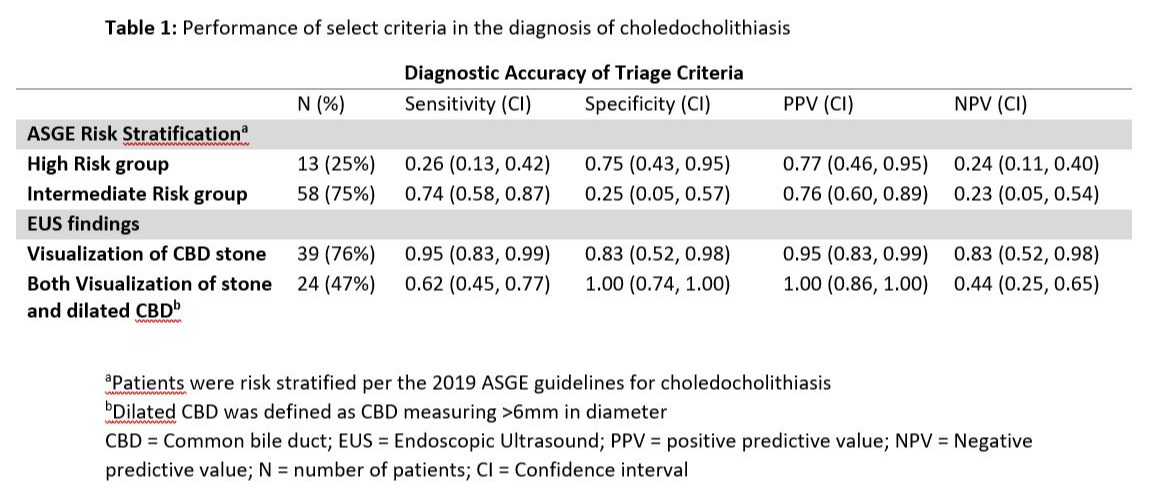Back
Poster Session E - Tuesday Afternoon
Category: Biliary/Pancreas
E0008 - Early EUS in Choledocholithiasis: A Prospective Study
Tuesday, October 25, 2022
3:00 PM – 5:00 PM ET
Location: Crown Ballroom
- JJ
Jake Jacob, MD
Baylor College of Medicine
Houston, Texas
Presenting Author(s)
Jake Jacob, MD, Alejandro Gonzalez, BS, Robert J. Sealock, MD
Baylor College of Medicine, Houston, TX
Introduction: Choledocholithiasis (CDL) is a common gastrointestinal problem that can lead to life-threatening illness if left untreated. The American Society for Gastrointestinal Endoscopy (ASGE) revised its risk stratification tool for suspected CDL in 2019, in which endoscopic ultrasound (EUS) is reserved for intermediate risk patients. This study aims to evaluate the performance of an early EUS strategy in the diagnosis and management of CDL.
Methods: This is a prospective, single center study of 51 patients admitted with suspicion for CDL. Patients with upper abdominal pain, acute elevation in LFTs ( >2x upper limit of normal), or transabdominal ultrasound or abdominal computed tomography (CT) were considered for the study. Exclusion criteria included clinical evidence of ascending cholangitis, history of post-surgical gastric or biliary anatomy, prior ERCP, or history of hepatobiliary malignancy. All suspected patients were initially triaged with EUS. Those with a dilated CBD ( >6mm) or stone visualized on EUS then underwent same-session ERCP. Those without EUS findings of choledocholithiasis were triaged according to the 2019 ASGE risk stratification guidelines for CDL. Patients in the high risk category underwent ERCP, and those in the intermediate risk category were scheduled for elective cholecystectomy. Only patients with confirmatory testing with ERCP were included in this study.
Results: Of the 51 patients, the average age was 40, BMI of 32, and the majority (78%) were female. 39 (76%) had stone visualized on EUS, 28 (55%) had a dilated CBD, and 24 (47%) had both visualized stone and dilated CBD. Stone visualized on EUS had a sensitivity of 95% and specificity of 83%. The combination of visualized stone and dilated CBD and a sensitivity of 62% and specificity of 100%. Of the 51 patients, 13 (25%) met criteria for high risk categorization, and 38 (51%) met criteria for intermediate risk categorization. The high risk categorization had a sensitivity of 26% and specificity of 75% for diagnosis of choledocholithiasis. Of the patients in the high risk category, EUS had a sensitivity and specificity of 100% for choledocholithiasis.
Discussion: EUS findings had a higher sensitivity and specificity for CDL than the high risk category per risk stratification. In the high risk category, EUS was effective in determining which patients would benefit from ERCP. Early EUS serves as a more effective triage than the 2019 risk stratification guidelines for CDL.

Disclosures:
Jake Jacob, MD, Alejandro Gonzalez, BS, Robert J. Sealock, MD. E0008 - Early EUS in Choledocholithiasis: A Prospective Study, ACG 2022 Annual Scientific Meeting Abstracts. Charlotte, NC: American College of Gastroenterology.
Baylor College of Medicine, Houston, TX
Introduction: Choledocholithiasis (CDL) is a common gastrointestinal problem that can lead to life-threatening illness if left untreated. The American Society for Gastrointestinal Endoscopy (ASGE) revised its risk stratification tool for suspected CDL in 2019, in which endoscopic ultrasound (EUS) is reserved for intermediate risk patients. This study aims to evaluate the performance of an early EUS strategy in the diagnosis and management of CDL.
Methods: This is a prospective, single center study of 51 patients admitted with suspicion for CDL. Patients with upper abdominal pain, acute elevation in LFTs ( >2x upper limit of normal), or transabdominal ultrasound or abdominal computed tomography (CT) were considered for the study. Exclusion criteria included clinical evidence of ascending cholangitis, history of post-surgical gastric or biliary anatomy, prior ERCP, or history of hepatobiliary malignancy. All suspected patients were initially triaged with EUS. Those with a dilated CBD ( >6mm) or stone visualized on EUS then underwent same-session ERCP. Those without EUS findings of choledocholithiasis were triaged according to the 2019 ASGE risk stratification guidelines for CDL. Patients in the high risk category underwent ERCP, and those in the intermediate risk category were scheduled for elective cholecystectomy. Only patients with confirmatory testing with ERCP were included in this study.
Results: Of the 51 patients, the average age was 40, BMI of 32, and the majority (78%) were female. 39 (76%) had stone visualized on EUS, 28 (55%) had a dilated CBD, and 24 (47%) had both visualized stone and dilated CBD. Stone visualized on EUS had a sensitivity of 95% and specificity of 83%. The combination of visualized stone and dilated CBD and a sensitivity of 62% and specificity of 100%. Of the 51 patients, 13 (25%) met criteria for high risk categorization, and 38 (51%) met criteria for intermediate risk categorization. The high risk categorization had a sensitivity of 26% and specificity of 75% for diagnosis of choledocholithiasis. Of the patients in the high risk category, EUS had a sensitivity and specificity of 100% for choledocholithiasis.
Discussion: EUS findings had a higher sensitivity and specificity for CDL than the high risk category per risk stratification. In the high risk category, EUS was effective in determining which patients would benefit from ERCP. Early EUS serves as a more effective triage than the 2019 risk stratification guidelines for CDL.

Figure: Performance of select criteria in the diagnosis of choledocholithiasis
Disclosures:
Jake Jacob indicated no relevant financial relationships.
Alejandro Gonzalez indicated no relevant financial relationships.
Robert Sealock indicated no relevant financial relationships.
Jake Jacob, MD, Alejandro Gonzalez, BS, Robert J. Sealock, MD. E0008 - Early EUS in Choledocholithiasis: A Prospective Study, ACG 2022 Annual Scientific Meeting Abstracts. Charlotte, NC: American College of Gastroenterology.
